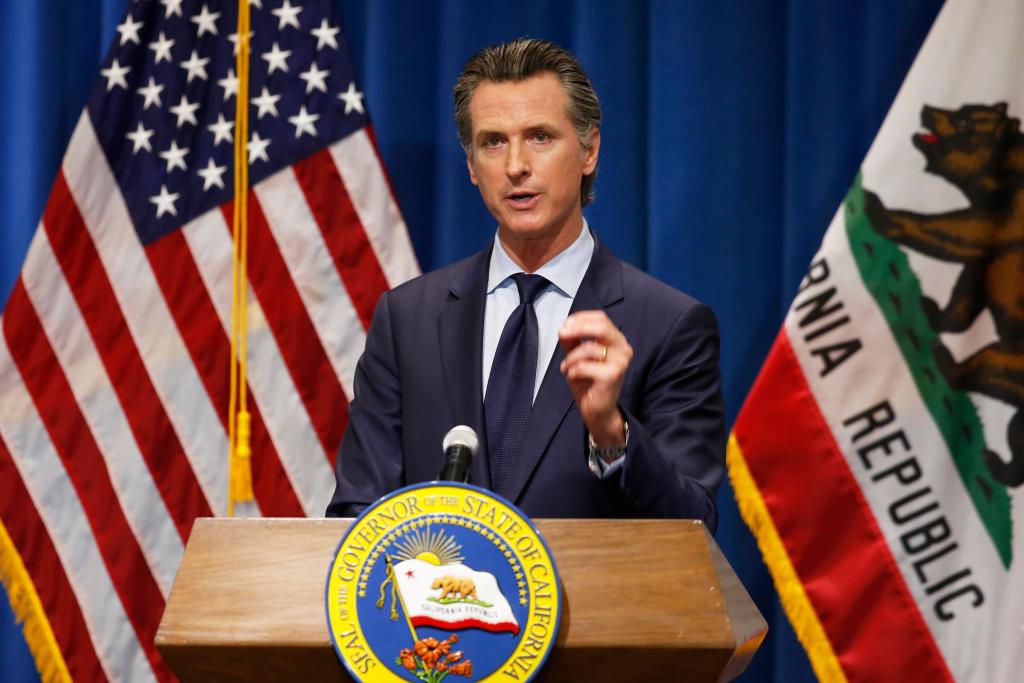California is confirming more coronavirus cases than ever before. The percentage of COVID-19 tests that come back positive is creeping up. And the number of people being treated for the deadly illness in hospitals and intensive care units is on the rise.
In the last week, the number of confirmed new coronavirus cases in the state has soared to record highs of more than 6,000 infections a day, well north of the 2,000-3,000 daily case totals that were common at the beginning of June. Moreover, there are more people hospitalized with the coronavirus this week than at any time since the pandemic began: As of Tuesday, there were 4,095 COVID-positive patients in California hospitals, up an alarming 32% from 3,092 just 10 days before.
At a news conference Wednesday, Gov. Gavin Newsom attributed the spread of the virus to increased social interactions — and a lack of social distancing — as counties continue to reopen, admonishing people who he said have “taken their guard down” after more than three months of tight restrictions on daily life.
“When we begin to go back to our old ways and our old habits, a consequence is we are spreading this virus,” Newsom said at a press conference Wednesday. “It is our behaviors that are leading to these numbers, and we are putting people’s lives at risk.”
Yet even as he warned about the surge of new cases, Newsom gave little indication that the state would stop or reverse course in its reopening process — instead putting the onus for containing the virus squarely on county governments and warning that the state could pull emergency funding from those counties that flout public health guidelines.
“We give an enormous amount of power, control and authority to local government, but what we’re now looking for is accountability,” Newsom said. He urged Californians to take a gradual approach to increasing social contact, noting that it is not so much a question of when businesses reopen as a question of how local governments and residents balance reopenings with concerns about public health.
“It’s not a binary choice — it’s not about shutting down the world’s fifth-largest economy or advancing these efforts” to protect public health, Newsom said. “We can do both.”
As the coronavirus spread across the U.S. in March, California moved faster and more aggressively than other states in enacting strict statewide lockdown orders to stop the spread. Since then, it has also been much slower than others in reopening.
But as the state has allowed shopping malls, stores, restaurants and other businesses to host customers again, the state — like several others across the West and South, including Florida, Arizona and Texas — has seen alarming increases.
The new surge has been particularly dramatic in Southern California — but case numbers are continuing to rise in the Bay Area as well. This week, Alameda County and Santa Clara County both saw daily records. Alameda reported 202 new cases Monday, more than any other day of the pandemic so far, and Santa Clara reported a record high 121 new cases Tuesday.
The number of confirmed positive patients in Bay Area hospitals also has risen consistently from 222 on June 18 to 304 on June 23 — a 37% jump. As of Wednesday, increased hospitalizations in Contra Costa County and Santa Clara County had landed those counties on a state watch list of areas that the California Public Health Department is monitoring for troubling coronavirus trends.
Local hospitals are seeing an influx of younger patients showing up in emergency rooms with the virus, said Russell Rodriguez, medical director of the emergency department at Walnut Creek-based John Muir Health. Because many of those patients are not sick enough to be admitted, he said, “they are discharged home to isolate themselves, monitor their symptoms and come back to the hospital if there are any significant changes.”
Testing for coronavirus is more widely available across California, but Newsom said that doesn’t fully explain the increase in cases. As of Tuesday, state data showed 5.1 percent of people tested for COVID-19 had the virus, compared to 4.6 percent just two weeks ago — a change Newsom called “profoundly impactful.”
UC San Francisco epidemiologist Dr. George Rutherford cautioned that the increase could also be due in part to public health officials better targeting testing in neighborhoods and settings, such as prisons and nursing homes, where the virus has been especially prevalent.
“It’s a cause for concern — I don’t think it’s a cause for panic,” Rutherford said.
In the meantime, Bay Area counties — which have generally moved even more slowly toward reopening than California as a whole — are now pushing forward.
San Mateo County, for instance, received permission from the state earlier this month to speed up its reopening process. Like elsewhere, the county is now seeing a rapid rise in new cases, reporting 240 new positive tests for coronavirus through the first three days of this week, compared to 168 all of last week.
“Right now it’s looking like things are going in the wrong direction,” said John Swartzberg, an infectious disease expert and professor emeritus at UC Berkeley.
“None of us knows what’s going to happen,” he added. “We’re trying to read tea leaves right now.”
Daniel Wu contributed to this report.



















